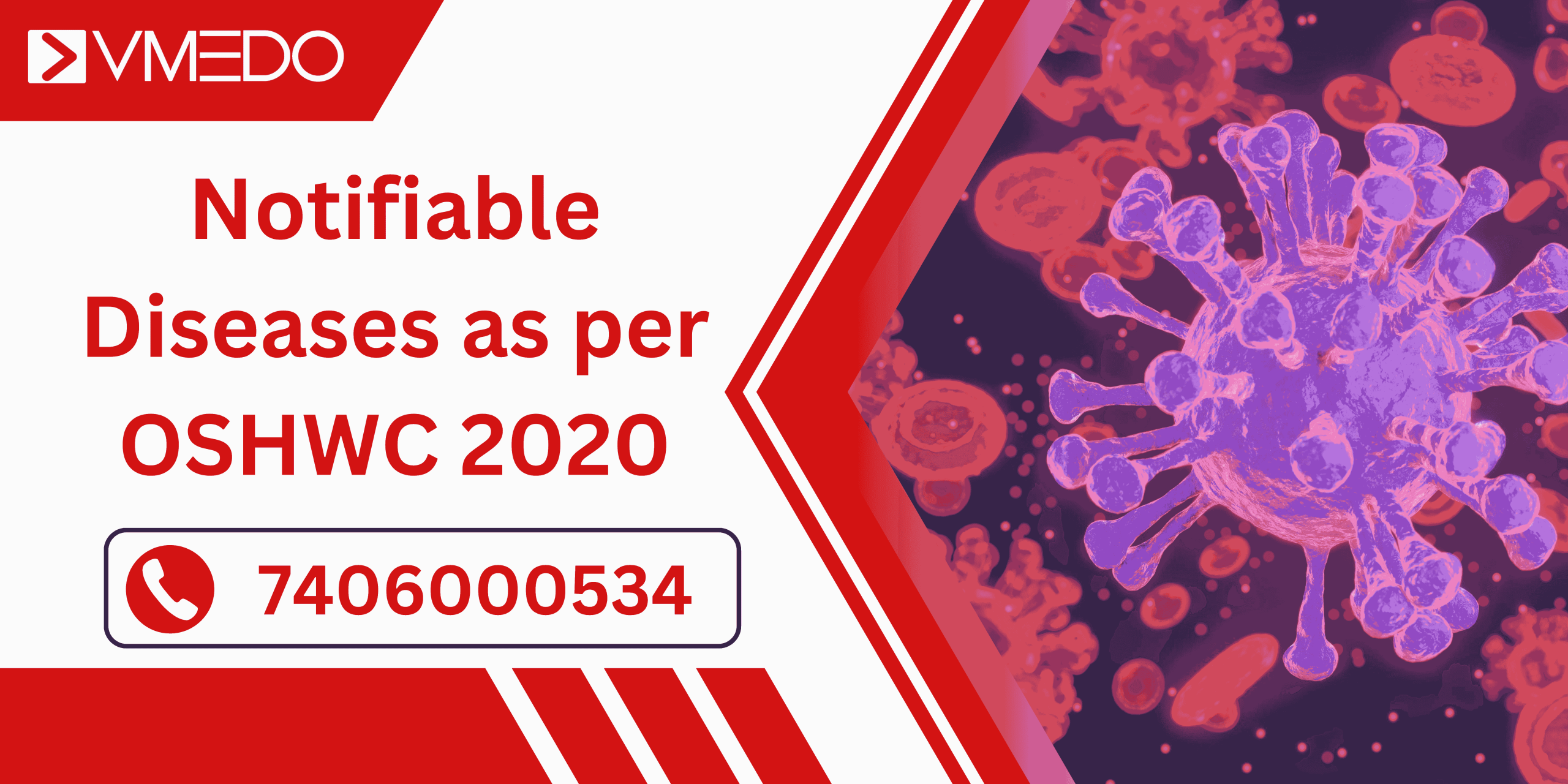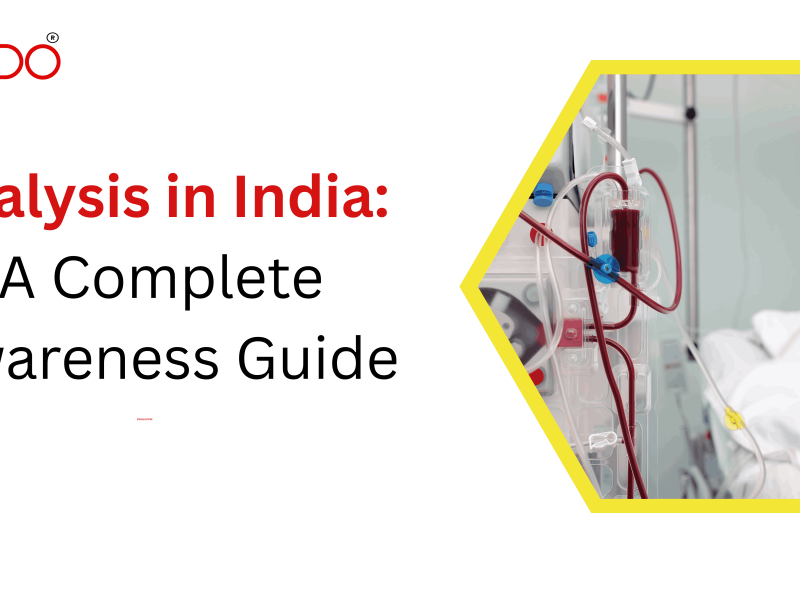In today’s evolving regulatory landscape, workplace health is no longer just a responsibility—it is a legal obligation. With the introduction of the Occupational Safety, Health and Working Conditions (OSHWC) Code, 2020, the Government of India has consolidated multiple labor laws to streamline compliance and ensure worker safety. A critical component of this code is the mandatory reporting of Notifiable diseases as per OSHWC 2020. For HR, EHS, and compliance officers, understanding what notifiable diseases are, why reporting them is essential, and the complete list of such diseases is crucial for maintaining both employee well-being and legal compliance. This blog will explore these aspects while also highlighting the employer’s responsibilities and how VMEDO supports companies in ensuring compliance and safeguarding workforce health.
What Are Notifiable Diseases as per OSHWC 2020?
Notifiable diseases are certain illnesses or health conditions that must be reported to government authorities by employers, medical officers, or healthcare providers when detected in the workplace. These diseases are considered significant from a public health and occupational hazard perspective. Prompt reporting helps prevent their spread and ensures timely intervention.
In the context of workplaces, especially factories, mines, ports, and construction sites, some diseases are caused or worsened due to exposure to harmful agents like dust, chemicals, or biological hazards. These are termed occupational diseases, and many of them are notifiable under the OSHWC Code.
The Legal Mandate: OSHWC 2020 & Notifiable Diseases
The OSHWC Code, 2020, under Section 12 (3) and Schedule I, makes it compulsory for employers to report any case of a notifiable disease occurring among workers. This regulation applies to all establishments falling under the code, which includes:
- Factories
- Mines
- Building and construction works
- Dock work
- Plantation and more
Failing to report notifiable diseases can lead to legal penalties, cancellation of licenses, and reputational damage.
Many companies overlook periodic medical surveillance. VMEDO offers preventive health screening and reporting solutions that help employers remain compliant with OSHWC 2020.
Why Reporting Notifiable Diseases Matters
- Legal Compliance
Avoid fines, legal notices, and non-compliance flags during audits. - Employee Health & Trust
Demonstrates your commitment to employee safety and builds a culture of trust. - Prevention of Outbreaks
Timely identification allows isolation and treatment—preventing wider workplace spread. - Government Coordination
Reporting helps health authorities take public health measures at a macro level.
Complete List of Notifiable Diseases under OSHWC 2020
Here’s the list as per Schedule I of the Code:
- Occupational anthrax
- Occupational leptospirosis
- Occupational tuberculosis
- Occupational brucellosis
- Occupational leptospiral meningitis
- Silicosis
- Asbestosis
- Byssinosis
- Coal workers’ pneumoconiosis
- Occupational asthma
- Occupational dermatitis
- Noise-induced hearing loss (NIHL)
- Occupational cancer
- Occupational cataract due to infrared radiation
- Diseases caused by lead, mercury, cadmium, arsenic, etc.
- Diseases due to ionizing radiation
- Bagassosis
- Occupational hypersensitivity pneumonitis
- Occupational heat stress disorder
- Occupational musculoskeletal disorders due to repetitive strain
- Chemical poisoning
- Any communicable disease contracted in the course of employment (e.g., COVID-19)
Set up a robust Occupational Health Centre (OHC) with VMEDO to enable timely diagnosis and documentation of such diseases.
Penalty for Non-Compliance
Under OSHWC 2020:
- Non-reporting can attract fines up to ₹2 lakh for the first offence.
- Continued non-compliance may lead to prosecution, license suspension, or cancellation of business operations.
We help you stay audit-ready. Our digital health records, on-site doctor services, and Form-17 reporting simplify your compliance.
Industries Most at Risk
The following sectors are particularly vulnerable to notifiable diseases:
| Industry | Common Occupational Disease |
| Mining | Pneumoconiosis, Silicosis |
| Construction | Asbestosis, Heat stress |
| Manufacturing | Chemical poisoning, Dermatitis |
| Textile | Byssinosis, Respiratory illness |
| Healthcare | Tuberculosis, Hepatitis |
| Agriculture | Leptospirosis, Anthrax |
How VMEDO Supports You
At VMEDO, we offer end-to-end Occupational Health Services to help industries comply with OSHWC Code regulations:
1. Occupational Health Centre Setup: We set up fully compliant OHCs with required equipment, forms, and staffing.
2. Medical Surveillance: Regular employee health checkups, including:
- PFT Tests
- Audiometry Tests
- Blood Tests
- ECG
- Vision screening test
3. On-site Medical Staff: Deploy qualified doctors and nurses to monitor worker health on a day-to-day basis.
4. Digital Health Records: Maintain Form-17 and other registers digitally for easy access during audits.
5. Reporting Assistance: Get help in preparing reports and documentation for submission to regulatory bodies.
Want to ensure compliance with OSHWC 2020?
FAQs: Notifiable Diseases as per OSHWC 2020
1. What is the OSHWC Code, 2020?
The Occupational Safety, Health and Working Conditions (OSHWC) Code, 2020 is a comprehensive legislation by the Government of India that consolidates and simplifies previous labor laws related to occupational health, safety, and working conditions in factories, mines, construction sites, and other establishments.
2. What are notifiable diseases under OSHWC 2020?
These are diseases listed in Schedule I of the OSHWC Code that employers must report to the appropriate authorities when diagnosed among workers. These include occupational illnesses like silicosis, asbestosis, tuberculosis, dermatitis, and more.
3. Who is responsible for reporting notifiable diseases at the workplace?
The employer or occupier of the establishment is legally responsible for reporting notifiable diseases. In some cases, attending medical officers may also be required to notify authorities.
4. To whom should notifiable diseases be reported?
They must be reported to the Chief Inspector-cum-Facilitator or designated government authority as per the state or central labor department guidelines.
5. What are the penalties for not reporting notifiable diseases?
Non-compliance can lead to fines up to ₹2 lakh for the first offence, and higher penalties or legal actions for repeated violations.
6. Is periodic health surveillance mandatory for all workers?
It is mandatory for workers employed in hazardous processes or exposed to chemical, physical, or biological agents. Regular check-ups help in early detection of notifiable diseases.
7. How often should health check-ups be done under OSHWC 2020?
Typically, health check-ups should be done annually, but frequency may vary based on industry risk level, age of employees, and local health authority directives.
8. Can third-party agencies like VMEDO assist in compliance?
Yes. VMEDO provides complete occupational health services including medical surveillance, doctor deployment, OHC setup, digital records, and compliance documentation support.



